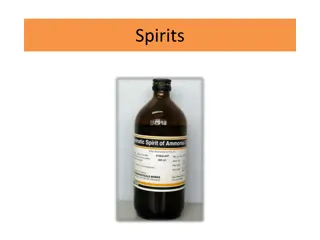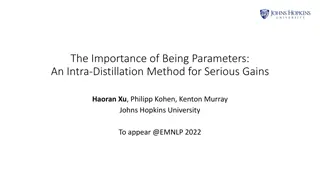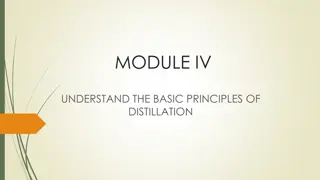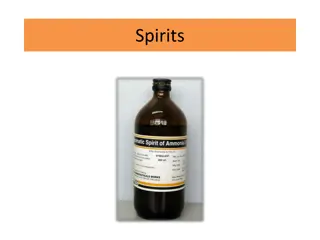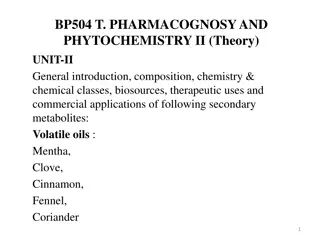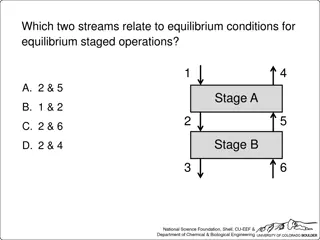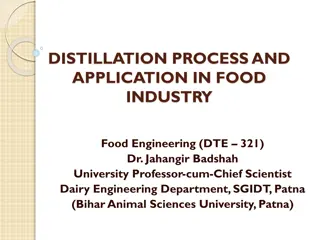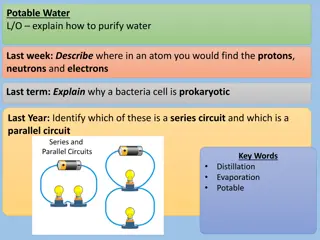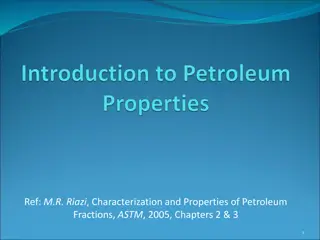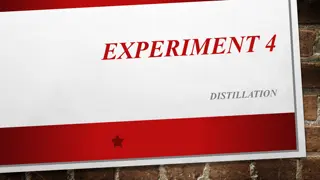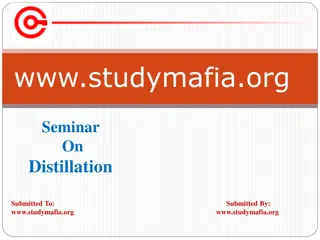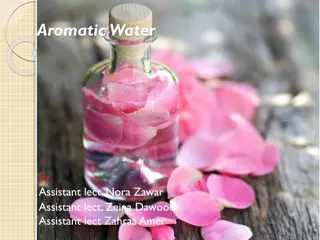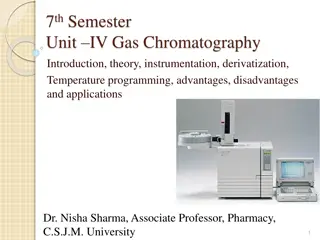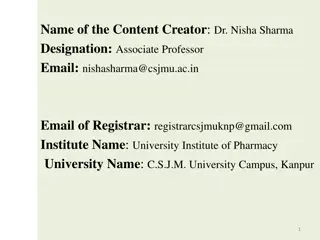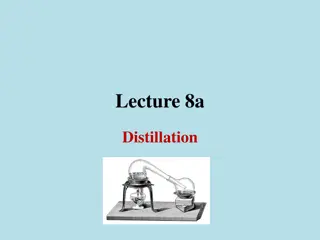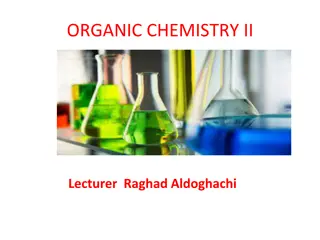Distillation: A Method for Separating Volatile Substances
Distillation is a method used in pharmacy to extract active principles, separate substances, and recover solvents. Simple distillation involves vaporizing a liquid, condensing the vapors, and collecting the liquid. It is commonly used for separating liquids from non-volatile solids under atmospheric pressure in laboratories. Proper equipment like a distillation flask, condenser, and receiver is essential for effective distillation.
Download Presentation

Please find below an Image/Link to download the presentation.
The content on the website is provided AS IS for your information and personal use only. It may not be sold, licensed, or shared on other websites without obtaining consent from the author. Download presentation by click this link. If you encounter any issues during the download, it is possible that the publisher has removed the file from their server.
E N D
Presentation Transcript
Distillation It is a method of separating volatile substances which differs appreciably in their vapour pressures. It is used in pharmacy either to extract volatile active principles from vegetable drugs or to separate volatile substances from impurities. It also provides a method of recovering volatile solvents notably, alcohol for further use. their less volatile
Simple distillation It is the process of converting a liquid into its vapors, transferring the vapors to another place and recovering the liquid by condensing the vapors usually by leading it into contact with a cold surface. The apparatus used is essentially consist of three parts. Still: In which the volatile material is vaporized Condenser: In which the vapors are condensed Receiver: In which the distillate is collected
Simple distillation is generally used for the separation of liquids from non-volatile solids. e.g. preparation of distilled water and recovery of alcohol in the preparation of dry extracts.
Simple distillation under atmospheric pressure For simple distillation in the laboratory, a distillation flask with a side arm sloping downwards is used. The temperature at which the vapors distil is observed on a thermometer, inserted through a cork and having its bulb just below the level of the side arm.
The flask should be of such a size that it is one-half to two-thirds full of the liquid to be distilled. Bumping due to superheating is avoided by adding a small chip of porous pot before distillation. Pot should not be added to the super heated liquid otherwise an instantaneous evolution of a large volume of vapors will occur. (These stones have pores inside which provide cavities both to trap air and to provide spaces where bubbles of solvent vapor can form. These bubbles ensure even boiling and prevent bumping and boiling over and loss of the solution)
Condenser It is a heat exchanger. It consist of a very large surface area which is kept cold by a stream of water on one side and the vapors are condensed on the other side. A large volume of cooling water is required on account of the latent heat of vaporization which is evolved on condensing the vapors.
In cooling 1g of water from 100 to 15, approximately 360 J are evolved In condensing 1g steam to water at 100 , 2.27 KJ are evolved. The latent heats of vaporization of alcohol and ether are 8.48 KJ and 3.78 KJ, respectively.
For the condensation of liquids which boil at from about 120 to 150 , a stream of cooling water may cause the condenser walls to crack, owing to the high temperature gradient across the walls; stationary water in the jacket is usually used in these cases. For liquids boiling above about 150 simple air cooling is used.
The main points in condenser are as follow The condenser must be so constructed as to be easily cleaned. The cooling surface must be large because the rate of condensation is proportional to the area of condensing surface.
The condensing surface must be reasonably good conductor of heat because the rate of condensation is proportional to the rate at which the surface conduct away the heat. For this reason, metal when suitable is preferable to glass
The film of condensed liquid is a bad conductor and must be removed quickly in order to avoid serious impairment of the efficiency of the condenser. The warmer water in contact with the condensing surface must be quickly carried away and its place taken by fresh cold water.
The cooling water is arranged to move on the counter current principle. Its direction of flow is opposite to that of the flow of vapors to be condensed.
In carrying out distillation on laboratory scale, the contents of the still are heated gradually and as the liquid begins to boil, the temperature recorded on the thermometer rises rapidly as the vapors ascends the neck of the flask. The temperature remains steady if the liquid is pure. Heating is then continued at such a rate that a drop of liquid every 1 to 2 seconds falls from the condenser.
When inflammable liquids are distilled, the distillate is collected in a second distillation flask attached to the condenser through a long rubber tubing.
Large scale When it is necessary to separate a volatile constituent such as alcohol or acetone from non-volatile extracts a simple form of still is used.
Simple distillation under reduced pressure Small scale Liquids which are unstable at their boiling point under atmospheric pressure, may be distilled at much lower temperature under reduced pressure with less decomposition. Solutions of thermolabile concentrated in the same way. substances may be
Distillation under reduced pressure is very commonly used for the evaporation of menstruum in the preparation of extracts. Vacuum distillation is most conveniently carried out in a claisen flask. The second neck prevents splashing of the violently agitated liquid.
Bumping occurs very readily during vacuum distillation but very easily prevented by means of a stream of air bubbles drawn out through a capillary dipping in the boiling liquid. It is advisable to use a water bath maintained at about 20 higher than the boiling point of the liquid under reduced pressure.
A small pressure guage (manometer) should be inserted between the pump and the receiver. In carrying out the distillation, heating is not commenced until the required vacuum is attained. Thin walled glass apparatus such as flat bottomed flasks and conical flasks should never be used for vacuum distillation.
In some instances persistent foaming occurs during vacuum distillation. This may be overcome by adding capryl alcohol to the liquid to be distilled or by inserting a second air capillary in the thermometer neck of a claisen flask.
Vacuum stills These are employed for distilling substances that have a high boiling point at atmospheric pressure or for substances that are damaged by high temperature or for removing the last traces of volatile solvents. To facilitate the collection and removal of the distillate without stopping the distillation, two receivers are fitted that may be used alternately.
Fractional distillation Fractional distillation is the process employed to separate miscible volatile liquids having different boiling points.
Vapor pressure of miscible liquids When the two components of a binary mixture are completely miscible the vapor pressure of the mixture is a function of the composition as well as the vapor pressures of the two pure components.
According to Raoult's law The partial vapor pressure of each volatile component is equal to the vapor pressure of the pure component multiplied by its mole fraction Thus for a mixture ofAand B PA=PA XA PB=PB XB
Where PAand PB components when the mole fractions are XAand XB respectively. The vapor pressure of the pure components are PA and PB The total vapor pressure P of the system is then PA+ PB are the partial vapor pressures of the
Binary mixtures that follow Raoult's law are those where the attraction between A and B molecules is the same as those for the pure components. e.g. benzene/toluene and paraffin mixtures. When the interaction of A and B molecules is less than between the molecules of pure constituents, the presence of B molecules reduce the A-A interaction and similarly the A molecules reduce the B-B interaction.
The partial vapor pressure is now greater than expected from Raoult's ideal solution law and the system is said to exhibit positive deviation e.g. benzene/ethyl alcohol , chloroform/ethyl alcohol. Negative deviation occurs when the A-B attraction is greater than the A-A or B-B attraction and the vapor pressure is less than expected, e.g. chloroform/acetone
The lower curve shows the manner in which the boiling point of the composition The upper curve relates the composition of the vapors in equilibrium with the liquid at the same temperature. The boiling point of the mixture X is T. The vapors at T will have a composition fixed by point Y, which corresponds to a mixture richer in B than in A. mixture changes with
If this vapor is condensed, a liquid having the composition (X1) will be obtained. The boiling point of the mixture X1is T1and when it is boiled, vapor having the composition Y1 yields a liquid X2on condensation is obtained. X2is nearly pure B. which
Hence in this example, extensive fractionation has been achieved by boiling the mixture and condensing the vapors in equilibrium with the liquid and repeating the process with the condensed vapors.
The volume of distillate (composition X2), obtained will be small, since as the vapor is drawn off, the liquid remaining in the still gradually becomes poorer in composition B and its boiling point rises. Fractional distillation is based on these principles.
Azeotropic mixtures An Azeotropic mixture or constant boiling point mixture is one in which the composition of the liquid and the vapor in equilibrium with it is the same. Thus the mixture behaves like a pure liquid. Miscible binary liquids form Azeotropic mixtures when the vapor pressure curve of the mixture exhibits a maximum or minimum.
Such components by distillation. It is possible to separate them into one component and a constant boiling mixture. Graph A; represents a mixture which posses a maximum vapor pressure, i.e. low boiling point azeotrope Graph B; represent a mixture with minimum vapor pressure, i.e. high boiling point azeotrope mixtures cannot be separated into pure
From A, it can be seen that repeated fractionation will produce a distillate tending to the composition of the Azeotropic mixture represented by point C. The material left in the still will be richer in B than it was original; eventually pure B will be left after the whole of A has been distilled off in the form of the Azeotropic mixture. If the original composition lies to the right of C then by similar reasoningAwill be left in the still.
Mixtures of minimum boiling point are more common than mixtures exhibiting a maximum boiling point, e.g. alcohol and water, alcohol and benzene, alcohol and chloroform.b n The boiling point of alcohol is 78.3 and the Bpt of water is 100 . when mixed to gather they form a mixture of minimum Bpt 78.15 , containing 95.57 per cent w/w alcohol.
The composition of mixtures of minimum Bpt varies with pressure as for example water and alcohol can be completely separated by distilling at 28 under 7cm pressure. On distilling a mixture of maximum Bpt, the distillate will be richer in the component A or B depending on whether the original concentration lies to the right or left of C.
Ternary mixtures Mixtures of three components which do not form azeotropes may be separated by fractional distillation in the same way as binary mixture. Azeotropic ternary mixtures of maximum vapor pressure (minimum Bpt) are important.
Water boiling point 100, alcohol boiling point 78.3, and benzene boiling point 80.2 , form a ternary Azeotropic mixture, boiling point 64.85 , containing 18.5% of alcohol, 7.4% of water and 74.1% of benzene. The boiling point of this mixture is lower than the boiling point of any binary mixture of any of the components.
Fractionation of this tertiary mixture is used on large scale for the production of absolute alcohol. Absolute alcohol can not be obtained by normal fractionation of dilute alcohol since a constant boiling mixture of 95.57 percent w/w is formed. Benzene is added to the alcohol-water azeotrope and when distilled the mixture yields first the ternary water-alcohol-benzene azeotrope, boiling point 64.85, until all the water is removed from the system.
Next a binary alcohol-benzene azeotrope, boiling point 68.2 distils over and finally absolute alcohol boiling point 78.3 is obtained. Trichloroethylene may be used instead of benzene in this process. Just enough benzene is added to the water/ethanol azeotrope to engage all of the water into the ternary azeotrope. When the mixture is then boiled, the azeotrope vaporizes leaving a residue composed almost entirely of the excess ethanol
Chemical action separation Another type of entrainer is one that has a strong chemical affinity for one of the constituents. Using again the example of the water/ethanol azeotrope, the liquid can be shaken with calcium oxide, which reacts strongly with water to form the nonvolatile compound, calcium hydroxide. Nearly all of the calcium hydroxide can be separated by filtration and the filtrate redistilled to obtain 100% pure ethanol.
Fractionating columns A fractionating column, which is inserted between the still and the condenser, acts by bringing about repeated distillation throughout the length of the column.
The action of the column is partially to condense the vapors rising from the boiling liquid; this condensate will be richer in the more volatile component than the original liquid and it is vaporized again by the condensation of more ascending vapors; the vapors so produced will be still richer in the more volatile components and when condensation and vaporization takes place further up the column, further enrichment in the more volatile components will be effected.
Under ideal conditions this will result in the lower boiling point component arriving at the top of the column and the higher boiling point component being left at the bottom of the column. Thus a temperature gradient will be established along the column when distillation is in progress, and ultimately the vapor passing out of the column will be very rich in the low boiling point component.



